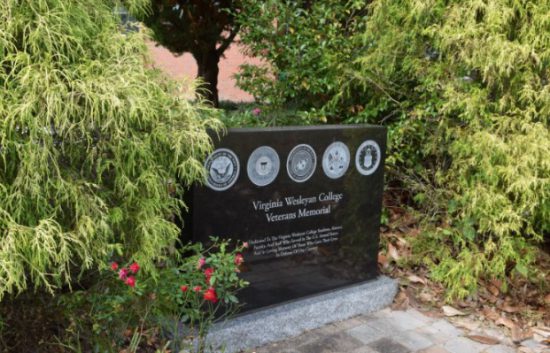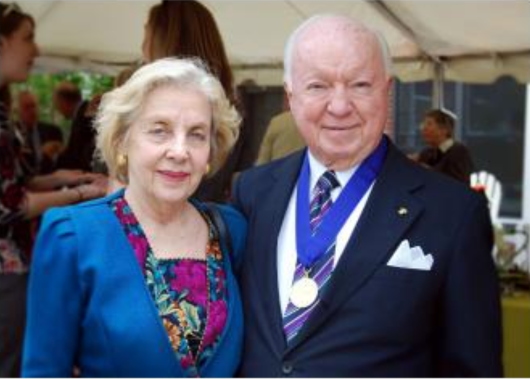Campus veteran’s memorial, located behind Godwin Hall
Nusbaum Center|Courtesy
Advocacy, resilience, community and sacrifice were the themes of the “If These Grounds Could Talk” guided tour given by the Robert Nusbaum Center on Thursday, Oct. 10.
The guided tour included sacred spots such as the John Wesley statue outside the chapel, the Heritage Plaque, Beech Grove, the Veterans Memorial, the Domestic Violence wall, AIDS Memorial walls and the Peace Garden. These places are considered sacred because they are places with great significance tied directly to the Virginia Wesleyan campus.
Dr. Craig Wansink, director of the Robert Nusbaum Center, has been involved with the center since its very beginning. He became the director in 2014. When asked what makes the center so special, he described being attracted to the opportunity and ability to bring together different disciplines. The Nusbaum Center’s main focus is to create civil society through education, respectful dialogue and mutual understanding.
“I frequently think that students’ education at Virginia Wesleyan is diminished if they do not recognize the name of the place,” Wansink said, “I think it consists of three parts, Virginia and Wesleyan and the university.”
The first sacred spot visited was the John Wesley statue. When speaking about the John Wesley statue, Wansink wanted to acknowledge not only the Methodist history John Wesley gave Virginia Wesleyan but also the work he did as a social advocate, visiting people in prisons and working with the poor and hungry, as well as speaking out against slavery in a time when such ideas would put his life in danger. This concept of doing great things for others in the face of adversity was a recurring topic on the walk.

AIDS Memorial Wall, located in Allen Village
Nusbaum Center|Courtesy
The tour then moved on to Beech Grove. Beech Grove is an old-growth beech forest, which became a symbol of student activism in 1991. Wansink explained that a construction project threatened its existence, and students rallied to advocate for the relocation of one building, which spared much of the grove. This show of advocacy was said to help lead to the environmental studies program we now have at Virginia Wesleyan.
The Heritage Plaque represented the land’s history and the property’s first institutional use. In 1866, a portion of the land on which Virginia Wesleyan now lies was used as a place of transition for newly freed slaves. The plaque, near Godwin Hall, contains this description. The tour leaders said it represented freedom and uplift.
The group was informed about the second institutional use of the property when we visited the next sacred spot, which was the Veterans Memorial. During World War II, a part of the land Virginia Wesleyan stands on was leased to build barracks for training pilots. The memorial itself, which is a plaque, honors those who served in the United States Armed Forces. The memorial was established in 2013 and is located behind Godwin Hall. The tour guides pointed out that every year on Veterans Day the VWU community gathers to reflect on the sacrifices of those who served during World War II.
Dr. Kathy Stolley, a Sociology professor, was another leader on this tour. She is credited with the idea of touring the sacred spots on campus. Stolley hoped that this tour allows students to gain a new perspective and appreciate the values upheld by the people who came before us.
Stolley stated that “Visiting and reflecting on these locations will allow us all to learn some history of VWU and offer us the opportunity to contemplate our values, the world we live in and the world we hope to live in.”
Stolley was the primary speaker when the group visited the Domestic Violence and AIDS Memorial walls. She described them as important in encouraging awareness and support about the issues. When the tour arrived at Allen Village, Stolley first introduced the Domestic Violence wall. The wall was started in 2008 and was originally designed when there was an active women’s center on campus. Stolley informed us that a group of students wanted a visual acknowledgment of domestic violence issues that was lasting. She described the wall as a place on campus that students can come to as a reflection area.
When asked which aspect of the tour spoke the most to her, Stolley stated, “The AIDS Memorial Wall speaks to me the most. It has layers of meaning. In brief, I remember the tragic early years of the epidemic, so I have those personal reflections. From a scholarly perspective, I wrote a book on HIV/AIDS and have done additional research and teaching on that topic. The stories and connections that the students, faculty, and staff had with the people remembered, and messages shared, on the blocks deserve to be honored.”
The AIDS Memorial Wall was started in 1999. Stolley informed the group that the wall was designed after the quilt project, which honored those who had died from the disease. Stolley also described The AIDS Memorial Wall as a timeline of the epidemic, the color of the outline of each square signifying the different times. Black was the first color, meaning those wall pieces symbolized the lives lost to the pandemic. Stolley pointed out that when the wall first went up, many people had to paint at night as it was not seen as a good thing to support the people who had AIDS at the time. A red outline highlighted the addition to the wall in 2008, focusing on spreading awareness about the disease. Finally, a blue outline represented a project done by middle schoolers. Combined, these sections represented a timeline of how society viewed the epidemic and sexually transmitted diseases, from hiding in the dark to paint, to young middle schoolers doing it as a project. Both the Domestic Violence and AIDS walls are placed in separate ends of Allen Village, with paintings on each wall tile with different messages bringing awareness to these issues.
Kelly Jackson, the associate director of the Nusbaum Center, described this opportunity as an “invitation to look beyond the visible” and how the sacred spots on campus show the history of resilience and advocacy on this land.
“Each space, from the Peace Garden to the Veterans’ Memorial, serves as a call to action, inspiring us to champion the causes that matter most to us and to recognize the profound impact we can have on others when we act with courage and compassion,” Jackson said.
The last sacred spot visited on the tour was the Peace Garden which Jackson shared was the spot that spoke most to her. Tour leaders described the Peace Garden as a symbol of peace, unity and community. You will find a Peace Pole in the center of the Peace Garden. On each side of the Peace Pole, the saying “May peace prevail on Earth” is inscribed in a different language. The hope of the Peace Garden was said to be having students walk through it and think about their roles in promoting peace in their lives and the world.
The final remarks of the tour were given by Wansink, who said to remember a quote from John Wesley: “Without love, all learning is but splendid ignorance, not this folly.” Wansink also shared that these sacred spots are sacred because of the risks and sacrifices taken by individuals who sought to do what is right and good.
By Mia Diehl
mjdiehl@vwu.edu

